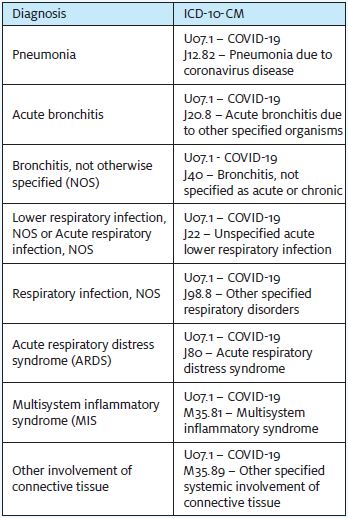Every year on October 1, the Centers for Medicare and Medicaid Services (CMS) and the National Center for Health Statistics release an updated ICD-10-CM Official Guidelines, as well as changes to the code set. This year there are 159 new codes, 32 deleted codes, and 20 revised codes, with a total of 72,748 codes to choose from. (Visit ICD-10-CM Official Guidelines for Coding and Reporting FY 2022 at https://www.cms.gov/files/document/fy-2022-icd-10-cm-coding-guidelines.pdf to see the entire document.)
Three common diagnoses for urgent care are cough (R05), low back pain (M54.5), and polyuria (R35.8). Starting October 1, 2021, you will need to add a digit for increased specificity.
Cough:
- Acute cough (R05.1)
- Subacute cough (R05.2)
- Chronic cough (R05.3)
- Cough syncope (R05.4)
- Other specified cough (R05.8)
- Cough, unspecified (R05.9)
Low back pain:
- Low back pain, unspecified (M54.50)
- Vertebrogenic low back pain (M54.51)
- Other low back pain (M54.59)
Polyuria:
- Nocturnal polyuria (R35.81)
- Other polyuria (R35.89)
Social determinants of health may have an impact on the level of risk used to determine the appropriate evaluation and management (E/M) code since implementation of the 2021 E/M guidelines. The American Medical Association defines social determinants of health as “economic and social conditions that influence the health of people and communities.” The examples provided include food or housing insecurity, but they could also include situations like a patient being unable to afford their medication or not understanding the directions from the provider due to a lack of education. There are codes to report these circumstances in the range Z55-Z65 and more detail is being added for 2022:
- Less than a high school diploma (Z55.5)
- Inadequate drinking-water supply (Z58.6)
- Homelessness unspecified (Z59.00)
- Sheltered homelessness (Z59.01)
- Unsheltered homelessness (Z59.02)
- Food insecurity (Z59.41)
- Other specified lack of adequate food (Z59.48)
- Housing instability, housed, with risk of homelessness (Z59.811)
- Housing instability, housed, homelessness in past 12 months (Z59.812)
- Housing instability, housed unspecified (Z59.819)
- Other problems related to housing and economic circumstances (Z59.89)
These codes would be reported as secondary diagnoses.
Other new diagnoses include:
- Depression, unspecified (F32.A)
- Irritant contact dermatitis (L24.A0 – L24.B3)
- Nonsuicidal self-harm (R45.88)
- Personal history of self-harm (Z91.51)
- Personal history of nonsuicidal self-harm (Z91.52)
- Feeding difficulties, unspecified (R63.30)
- Pediatric feeding disorder, acute (R63.31)
- Pediatric feeding disorder, chronic (R63.32)
- Other feeding difficulties (R63.39)
- Abnormal findings of blood amino-acid level (R79.83)
- Encounter for immunization safety counseling (Z71.85)
Finally, there is an entire section for conditions caused by use of cannabis or synthetic cannabinoids. The codes previously described as cannabis (derivatives) were deleted.
Poisoning:
- Cannabis (T40.711A–T40.714S)
- Synthetic cannabinoids (T40.721A–T40.724S)
Adverse effect:
- Cannabis (T40.715A–T40.715S)
- Synthetic cannabinoids (T40.725A–T40.725A)
Underdosing:
- Cannabis (T40.716A–T40.716S)
- Synthetic cannabinoids (T40.726A–T40.726S)
Code U09.9 (Post COVID-19 condition, unspecified)
This is the only COVID-19 code added for this update. It is to be used for sequela of COVID-19 or associated symptoms/conditions following a previous infection. It should not be used for current infections. First code the current symptoms/conditions, then add code U09.9 as a secondary diagnosis.
With the number of times the diagnosis coding rules have changed for COVID-19 since this all began; it may be a good time for a refresher.
Positive Diagnosis of COVID-19
Only confirmed cases as documented by the provider or confirmed by test results should be coded with ICD U07.1. This code should be the primary diagnosis on the claim. Additional diagnoses should be used to report manifestations.

If MIS develops as a result of a previous COVID-19 infection, report codes M35.81 and U09.9. If the provider does not document that the MIS is due to the previous COVID-19 infection, report codes M35.81 and Z86.16. If the patient has a known or suspected exposure to COVID-19, and no current COVID19 infection or history of COVID-19, report codes M35.81 and Z20.822.
Additional codes should be assigned for any associated complications of MIS.
No Definitive Diagnosis of COVID-19
Symptomatic patients
Signs and symptoms without a definitive diagnosis should be reported with the code for each presenting problem. Some examples are:
- R05.1-R05.9 – Cough
- R06.02 – Shortness of breath
- R50.9 – Fever, unspecified
- R68.83 – Chills (without fever)
- R69.89 – Rigors
- M79.10 – Muscle pain
- R51 – Headache
- J02.9 – Sore throat
- R07.0 – Pain in throat
- R43.0 – Loss of smell
- R43.9 – Loss of taste
- R19.7 – Diarrhea
- R11.0 – Nausea without vomiting
- R11.11 – Vomiting without nausea
- R11.2 – Nausea and vomiting
- R07.9 – Chest pain (central)
- R07.89 – Chest pain (anterior)
- R07.89 – Chest Pain (non-cardiac)
- R07.1 – Chest pain on breathing
This is not a comprehensive list. If the identified signs and symptoms are not on the list above, use the most appropriate ICD-10 available.
Include ICD Z20.822 (Contact with and (suspected) exposure to COVID-19) in addition to the symptoms to identify the services as COVID-19 related.
Asymptomatic patients
Asymptomatic patients with actual or suspected exposure should be coded with ICD Z20.822. Per the official guidelines, during the COVID-19 pandemic, a screening code is “generally not appropriate” as all of us may have been exposed. Even COVID-19 testing for preoperative testing should be coded as exposure, ICD Z20.822.
Other diagnoses for reporting COVID-19 related services include:
- History of COVID-19: Z86.16 (Personal history of COVID-19)
- Follow-up visits after COVID-19 has resolved without residual symptom(s) or condition(s): Z09 (Encounter for follow-up examination after completed treatment for conditions other than malignant neoplasm), and Z86.16
- Encounter for antibody testing: Z01.84 (Encounter for antibody response examination)
- Screening for COVID-19: Z11.52 (Encounter for screening for COVID-19)
Remember to always read the full description of the code to make sure you are using it correctly.

